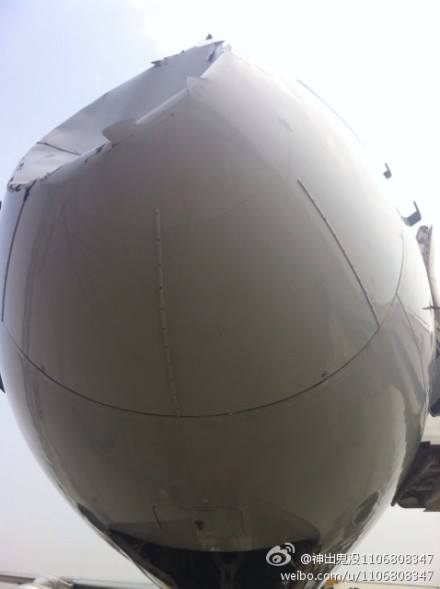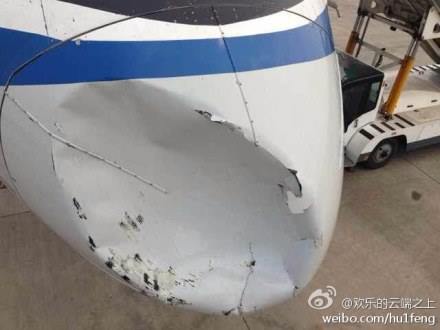It looks like you're using an Ad Blocker.
Please white-list or disable AboveTopSecret.com in your ad-blocking tool.
Thank you.
Some features of ATS will be disabled while you continue to use an ad-blocker.
share:
I searched this title and then searched "plane hit at 26,000 ft"..I got nothing, so if it's been posted please remove or whatever you do...
My husband just sent me this link from FB RSOE EDIS. I know you guys dont like the FB links so here is what it said:
Air China B752 near Chengdu on Jun 4th 2013, "slightly rearranged
Updated 7 hours ago · Taken in Chengdu, Sichuan
An Air China Boeing 757-200, registration B-2856 performing flight CA-4307 from Chengdu to Guangzhou (China), was climbing through FL260 when a large bang was heard from the nose section of the aircraft and the aircraft performance worsened.



I some comments argued that it was a bird or possible a drone..just putting it here to see what you guys come up with.
My husband just sent me this link from FB RSOE EDIS. I know you guys dont like the FB links so here is what it said:
Air China B752 near Chengdu on Jun 4th 2013, "slightly rearranged
Updated 7 hours ago · Taken in Chengdu, Sichuan
An Air China Boeing 757-200, registration B-2856 performing flight CA-4307 from Chengdu to Guangzhou (China), was climbing through FL260 when a large bang was heard from the nose section of the aircraft and the aircraft performance worsened.



I some comments argued that it was a bird or possible a drone..just putting it here to see what you guys come up with.
Very interesting OP. Honestly I don't think there is a bird species that flies at almost 27,000 feet so what else is there at that altitude? Drones?
maybe...
Ice from weather in the area perhaps?
A piece of debris from another aircraft in the area?
All seem possible. I will be interested to hear more about what they come up with.
Ice from weather in the area perhaps?
A piece of debris from another aircraft in the area?
All seem possible. I will be interested to hear more about what they come up with.
edit on 6-6-2013 by Springheel Jack because: (no reason given)
Cool find! Thanks for posting it!
From looking at the damage, I would guess a soft object. If it was hard, it probably would have gone through the metal.
Perhaps a drone, hobbyist experiment, balloon, or someone with the power to fly, but not superhuman strength.
The colors left on the image are interesting too, no blood from what I see.
From looking at the damage, I would guess a soft object. If it was hard, it probably would have gone through the metal.
Perhaps a drone, hobbyist experiment, balloon, or someone with the power to fly, but not superhuman strength.
The colors left on the image are interesting too, no blood from what I see.
At that altitude, there is so little oxygen that no creature can survive unaided and it is also very cold, so the ice theory may pan out, but a chunk
of ice that large wouldn't just hang in the air. Very interesting post, the only reasonable(non-CT) answer that comes to my mind as a possibility is
that it may have been a piece of falling space "junk". There was paint transfer from the plane to the object, whatever it was, but no paint
transfer to the plane, which leads me to think that it is either space "junk" which would be an old satellite, meteor, etc, and satellites are
usually not painted with anything other than maybe a reflective gloss. A drone would have been visible to the pilot long before it hit, and the angle
of the dent makes it seem it came from above, probably a 30 degree angle, wish I knew what direction the plane was travelling because that would rule
out artificial space debris, all satellites go the same direction, or at least any satellite that would have been old enough to fall without notice...
Hope someone finds out more details to this, I am really curious now...
Hi sorry reply is short and sweet I'm on my phone, this link may not work
exyuaviation.blogspot.co.uk...
I googled nose damage to aircraft and looked for images and found a similar picture to yours
Edit: just read what happened to the aircraft in the link I provided it was strike by a bird when the aircraft was coming into land.
exyuaviation.blogspot.co.uk...
I googled nose damage to aircraft and looked for images and found a similar picture to yours
Edit: just read what happened to the aircraft in the link I provided it was strike by a bird when the aircraft was coming into land.
edit on
6-6-2013 by ThePeaceMaker because: Added text
It's most likely hail. We used to see minor damage to aircraft when they flew through thunderstorms with small hail in them. They always came back
with the leading edges, and the nose stripped of paint, and after some storms with dents all around the nose, which would mean replacing the radome
(it's just fiberglass).
A UAV or a bird would have holed the radome, where a skipping blow from hail wouldn't. Most bird strikes leave a tear in the radome, and blood all over them. A UAV, would be hard enough that it would tear the radome as well.
A UAV or a bird would have holed the radome, where a skipping blow from hail wouldn't. Most bird strikes leave a tear in the radome, and blood all over them. A UAV, would be hard enough that it would tear the radome as well.
The damage is consistent with somthing small , I think the speed of the aircraft rather than the size of the object impacted is more important,
Probably Ice.
Originally posted by Jekka
At that altitude, there is so little oxygen that no creature can survive unaided and it is also very cold, so the ice theory may pan out, but a chunk of ice that large wouldn't just hang in the air. Very interesting post, the only reasonable(non-CT) answer that comes to my mind as a possibility is that it may have been a piece of falling space "junk". There was paint transfer from the plane to the object, whatever it was, but no paint transfer to the plane, which leads me to think that it is either space "junk" which would be an old satellite, meteor, etc, and satellites are usually not painted with anything other than maybe a reflective gloss. A drone would have been visible to the pilot long before it hit, and the angle of the dent makes it seem it came from above, probably a 30 degree angle, wish I knew what direction the plane was travelling because that would rule out artificial space debris, all satellites go the same direction, or at least any satellite that would have been old enough to fall without notice... Hope someone finds out more details to this, I am really curious now...
Great point, it could have been something falling from above.
I'm glad you noticed the "paint transfer" too, as is so common in collisions with paint involved.
reply to post by Jekka
Not true. There are geese that have been tracked over the Himalayan Mountains over 21,000 feet high, swans have been seen at 27,000 feet, and a species of vulture was sucked into a jet engine over Africa at over 37,000 feet.
archive.audubonmagazine.org...
So it quite easily could have been a bird.
Not true. There are geese that have been tracked over the Himalayan Mountains over 21,000 feet high, swans have been seen at 27,000 feet, and a species of vulture was sucked into a jet engine over Africa at over 37,000 feet.
One evening during a Himalayan expedition, he was startled by the honking of night-flying bar-headed geese passing directly over Mount Makalu's 27,824-foot summit. This experience caused Swan to speculate that the species had originally settled in India before collisions between the tectonic plates under the Hima-layas had pushed the range up.
Several other bird species regularly brave extreme altitudes. Among them are whooper swans, which were once observed by a pilot at 27,000 feet over the Atlantic Ocean between Iceland and the European continent, and bar-tailed godwits, which have been spotted at almost 20,000 feet. And then there's the occasional hardy individual that makes a high-altitude cameo.
The highest-flying bird ever recorded was a Ruppell's griffon, a vulture with a wingspan of about 10 feet; on November 29, 1975, a Ruppell's griffon was sucked into a jet engine 37,900 feet above the Ivory Coast--more than a mile and a half higher than the summit of Mount Everest. The plane was damaged, though it landed safely.
In 1924 a yellow-billed chough, a crowlike bird that's among the highest-nesting species, followed a climbing expedition's food scraps to 26,500 feet on Everest. The avian altitude record in North America is held by a mallard, which collided with an airplane on July 9, 1963, at 21,000 feet above Elko, Nevada.
archive.audubonmagazine.org...
So it quite easily could have been a bird.
edit on 6/6/2013 by Zaphod58 because: (no reason given)
My guess would be structural failure of the nose cone from air pressure.
I'm not an aeronautical engineer but I did stay at a Holiday Inn Express last night.
I'm not an aeronautical engineer but I did stay at a Holiday Inn Express last night.
The paint transfer ? You mean the black marks around the edges I agree though that altitude couldn't of been a bird
Edit: after posting this I was going to search for altitudes of bird but zaphod beat me to it
Edit: after posting this I was going to search for altitudes of bird but zaphod beat me to it
edit on 6-6-2013 by ThePeaceMaker because:
Because I'm an idiot
reply to post by Beartracker16
That's another possibility. Not likely, due to the black marks on the radome, but it's possible. It wouldn't be the first time it's happened.
That's another possibility. Not likely, due to the black marks on the radome, but it's possible. It wouldn't be the first time it's happened.
reply to post by Zaphod58
Would you expect to see some blood when hitting a bird in a plane at those speeds? Also, what are the colors on the nosecone from, a bird?
Would you expect to see some blood when hitting a bird in a plane at those speeds? Also, what are the colors on the nosecone from, a bird?
Originally posted by Beartracker16
I'm not an aeronautical engineer but I did stay at a Holiday Inn Express last night.
Fantastic reply I'm using that, made me chuckle
Surely the pilots have made a report....I'm sure they have an informed idea of what they hit.
If the report can be accessed publicly case solved.
If the report can be accessed publicly case solved.
reply to post by Philippines
Oh yes, you normally do.
Warning, Graphic images of bird strikes:
Not every bird strike will leave blood, or tear a hole in the fuselage, but over 90% of them do, depending on the size of the birds, and how they impact the aircraft.
As for the black marks, that is why I'm saying it's probably hail causing it. I've seen jets come back with marks on them from hail impacts, and some come back with paint stripped off after hail impacts. It all depends on the size, and what the hail forms around.
Oh yes, you normally do.
Warning, Graphic images of bird strikes:
Not every bird strike will leave blood, or tear a hole in the fuselage, but over 90% of them do, depending on the size of the birds, and how they impact the aircraft.
As for the black marks, that is why I'm saying it's probably hail causing it. I've seen jets come back with marks on them from hail impacts, and some come back with paint stripped off after hail impacts. It all depends on the size, and what the hail forms around.
Originally posted by Philippines
reply to post by Zaphod58
Would you expect to see some blood when hitting a bird in a plane at those speeds? Also, what are the colors on the nosecone from, a bird?
I suppose that the dark colors could just be exposed primer or metal.
A bird strike could also leave dark marks if the bird's plumage was dark. I have seen skin left on the paint of a car after a person was hit. The person had dark skin and it showed up on the red paint as black.
ETA: Now that I saw Z's bird strike pics, I don't know. If the strike occurred at 27k, and the flew though lower altitude precipitation, I guess blood could have rinsed off?
edit on 6-6-2013 by butcherguy because: (no reason given)
I may be wrong, but the black marks are more like missing paint revealing the black colour underneath, you can even see black where the white paint
has peeled.
I'd go for a glancing blow from a space ice ball or rough meteor fragment. There seems to be no signs of an animal cadaver.
I'd go for a glancing blow from a space ice ball or rough meteor fragment. There seems to be no signs of an animal cadaver.
edit on 6-6-2013 by
smurfy because: Text.
reply to post by Zaphod58
The only issue I have with that is that if they hit hail it would have left marks on the rest of the plane too, I have never heard, meteorologically speaking, of a hail spot in a cloud. Correct me if I'm wrong, but weather patterns tend to span miles and are usually predicted and avoidable, plus the story wouldn't have been published if it was just hail. The pics are awesome, but the pilot reported hitting "something"
The only issue I have with that is that if they hit hail it would have left marks on the rest of the plane too, I have never heard, meteorologically speaking, of a hail spot in a cloud. Correct me if I'm wrong, but weather patterns tend to span miles and are usually predicted and avoidable, plus the story wouldn't have been published if it was just hail. The pics are awesome, but the pilot reported hitting "something"
new topics
-
4/27/24 New Jersey Earthquake
Fragile Earth: 1 minutes ago -
Fun with extreme paints
Interesting Websites: 1 hours ago -
CIA is alleged to be operat social media troll frms in Kyiv
ATS Skunk Works: 2 hours ago -
Rainbow : Stargazer
Music: 3 hours ago -
I sleep no more.
Philosophy and Metaphysics: 5 hours ago -
Canada caught red-handed manipulating live weather data and make it warmer
Fragile Earth: 5 hours ago -
Why Files Our Alien Overlords | How We Secretly Serve The Tall Whites
Aliens and UFOs: 7 hours ago -
Curse of King Tuts Tomb Solved
Ancient & Lost Civilizations: 8 hours ago -
What allies does Trump have in the world?
ATS Skunk Works: 8 hours ago
top topics
-
Canada caught red-handed manipulating live weather data and make it warmer
Fragile Earth: 5 hours ago, 15 flags -
BIDEN Admin Begins Planning For January 2025 Transition to a New President - Today is 4.26.2024.
2024 Elections: 17 hours ago, 10 flags -
Why Files Our Alien Overlords | How We Secretly Serve The Tall Whites
Aliens and UFOs: 7 hours ago, 9 flags -
Curse of King Tuts Tomb Solved
Ancient & Lost Civilizations: 8 hours ago, 7 flags -
What allies does Trump have in the world?
ATS Skunk Works: 8 hours ago, 3 flags -
CIA is alleged to be operat social media troll frms in Kyiv
ATS Skunk Works: 2 hours ago, 3 flags -
Fun with extreme paints
Interesting Websites: 1 hours ago, 1 flags -
I sleep no more.
Philosophy and Metaphysics: 5 hours ago, 1 flags -
Rainbow : Stargazer
Music: 3 hours ago, 0 flags -
4/27/24 New Jersey Earthquake
Fragile Earth: 59 seconds ago, 0 flags
active topics
-
President BIDEN's FBI Raided Donald Trump's Florida Home for OBAMA-NORTH KOREA Documents.
Political Conspiracies • 43 • : BingoMcGoof -
4/27/24 New Jersey Earthquake
Fragile Earth • 0 • : FlyersFan -
BIDEN Admin Begins Planning For January 2025 Transition to a New President - Today is 4.26.2024.
2024 Elections • 28 • : budzprime69 -
SHORT STORY WRITERS CONTEST -- April 2024 -- TIME -- TIME2024
Short Stories • 28 • : argentus -
Definitive 9.11 Pentagon EVIDENCE.
9/11 Conspiracies • 432 • : Lazy88 -
Silent Moments --In Memory of Beloved Member TDDA
Short Stories • 71 • : zosimov -
I sleep no more.
Philosophy and Metaphysics • 7 • : GeorgeVanTassel -
Falkville Robot-Man
Aliens and UFOs • 14 • : GeorgeVanTassel -
Gov Kristi Noem Shot and Killed "Less Than Worthless Dog" and a 'Smelly Goat
2024 Elections • 85 • : UpIsNowDown2 -
Supreme Court Oral Arguments 4.25.2024 - Are PRESIDENTS IMMUNE From Later Being Prosecuted.
Above Politics • 116 • : Sookiechacha
